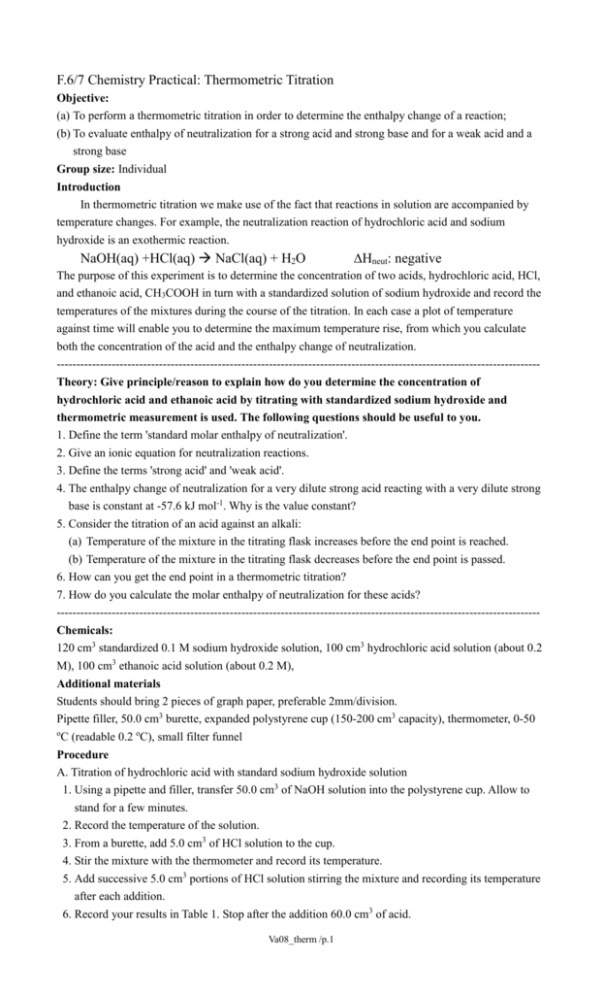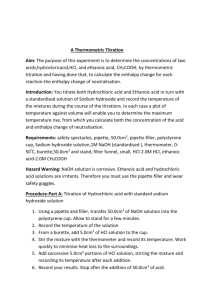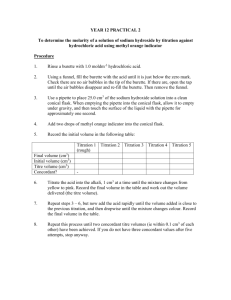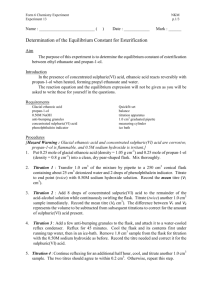VA08
advertisement

F.6/7 Chemistry Practical: Thermometric Titration Objective: (a) To perform a thermometric titration in order to determine the enthalpy change of a reaction; (b) To evaluate enthalpy of neutralization for a strong acid and strong base and for a weak acid and a strong base Group size: Individual Introduction In thermometric titration we make use of the fact that reactions in solution are accompanied by temperature changes. For example, the neutralization reaction of hydrochloric acid and sodium hydroxide is an exothermic reaction. NaOH(aq) +HCl(aq) NaCl(aq) + H2O Hneut: negative The purpose of this experiment is to determine the concentration of two acids, hydrochloric acid, HCl, and ethanoic acid, CH3COOH in turn with a standardized solution of sodium hydroxide and record the temperatures of the mixtures during the course of the titration. In each case a plot of temperature against time will enable you to determine the maximum temperature rise, from which you calculate both the concentration of the acid and the enthalpy change of neutralization. --------------------------------------------------------------------------------------------------------------------------Theory: Give principle/reason to explain how do you determine the concentration of hydrochloric acid and ethanoic acid by titrating with standardized sodium hydroxide and thermometric measurement is used. The following questions should be useful to you. 1. Define the term 'standard molar enthalpy of neutralization'. 2. Give an ionic equation for neutralization reactions. 3. Define the terms 'strong acid' and 'weak acid'. 4. The enthalpy change of neutralization for a very dilute strong acid reacting with a very dilute strong base is constant at -57.6 kJ mol-1. Why is the value constant? 5. Consider the titration of an acid against an alkali: (a) Temperature of the mixture in the titrating flask increases before the end point is reached. (b) Temperature of the mixture in the titrating flask decreases before the end point is passed. 6. How can you get the end point in a thermometric titration? 7. How do you calculate the molar enthalpy of neutralization for these acids? --------------------------------------------------------------------------------------------------------------------------Chemicals: 120 cm3 standardized 0.1 M sodium hydroxide solution, 100 cm3 hydrochloric acid solution (about 0.2 M), 100 cm3 ethanoic acid solution (about 0.2 M), Additional materials Students should bring 2 pieces of graph paper, preferable 2mm/division. Pipette filler, 50.0 cm3 burette, expanded polystyrene cup (150-200 cm3 capacity), thermometer, 0-50 o C (readable 0.2 oC), small filter funnel Procedure A. Titration of hydrochloric acid with standard sodium hydroxide solution 1. Using a pipette and filler, transfer 50.0 cm3 of NaOH solution into the polystyrene cup. Allow to stand for a few minutes. 2. Record the temperature of the solution. 3. From a burette, add 5.0 cm3 of HCl solution to the cup. 4. Stir the mixture with the thermometer and record its temperature. 5. Add successive 5.0 cm3 portions of HCl solution stirring the mixture and recording its temperature after each addition. 6. Record your results in Table 1. Stop after the addition 60.0 cm3 of acid. Va08_therm /p.1 B. Titration of ethanoic acid with standard sodium hydroxide solution 7. Follow the same procedure as you did for the titration of HCl, except that you use ethanoic acid in the burette. When filling the burette, remember to use correct rinsing procedures. If in doubt, ask your teacher. 8. Record your results in table 2. Data and Results Concentration of standardized sodium hydroxide solution: ___________ mol dm-3 Table 1 Volume of HCl added / cm3 0.0 5.0 10.0 15.0 20.0 25.0 30.0 35.0 40.0 45.0 50.0 55.0 Temperature / oC By the use of the above data plot temperature of the reaction mixture versus volume of hydrochloric acid added. Determine the end point. Table 2 Volume of CH3COOH added / cm3 0.0 5.0 10.0 15.0 20.0 25.0 30.0 35.0 40.0 45.0 50.0 55.0 Temperature / oC By the use of the above data plot temperature of the reaction mixture versus volume of ethanoic acid added. Determine the end point. Calculation 1. Treatment of the graphs: At the beginning and the final stage of the titration, the points should show a straight line relationship. Then draw a straight line for each of the stage. Extrapolate these straight lines such that they meet at a point. This point should be above and quite close to the maximum temperature. It is the end point of the titration. This point also gives you the maximum temperature of the reaction mixture. 2. Calculate concentration of each of the acids. 3. From the maximum temperature rise, determine the quantity of energy released in each titration. Assume that the specific heat capacity of the solutions is the same as that for water, 4.18 J g-1 K-1 and that the heat capacity of the cup is zero. 4. Calculate the standard enthalpy change of neutralization for each reaction. Discussion (Write this section with the help of the following questions) 1. What are the error sources? 2. The maximum point you obtained is accepted as the end point. Why? 3. 4. Experimental results for hydrochloric acid are usually a little less negative than -57.6 kJ mol-1. Suggest two reasons for this. Suggest a reason why the enthalpy of neutralization for the reactions involving weak acids are always less negative(not so exothermic) compared to the reactions between strong acids and strong bases. You may take ethanoic acid as an example. END Va08_therm /p.2







